In an effort to understand and explain the persistence of certain fundamental problems in elite dressage, I have written a short series of articles. In the first article, I discussed the consistent misunderstanding of bend and its seismic effect on performances. In this article, I want to address hollowness in the horse’s back, which is increasingly seen, and worse, is becoming acceptable in elite dressage particularly as it relates to collection.
The Problem:’The hind legs staying out behind, the hollow back seemingly locked down in all the work.’
(if you missed part one, go here)
I just finished watching a video of two competitive riders on a national equestrian team, riding the Grand Prix test. At the halt in front of the judges, the two horses were practically identical. Both were square, but their hocks were out behind and their backs were down. Throughout the tests, especially at the trot, there was an obvious effort to exaggerate the suspension, but there was no proper engagement. At the piaffe segment, it got worse. The hind legs stayed out behind the hollow back seemingly locked down in all the work. I also watched a lesson with a well-known competitive trainer from the Iberian Peninsula, who was giving advice for making the transition from piaffe to passage, while the rider’s horse was completely hollow. This kind of performance in and out of the competitive arena is not uncommon. So what is going on here? Is it bad riding? Certainly the improperly driving seats of riders who are unbalanced, with their weight falling behind their legs, can drive the horse’s backs down. Overuse of the reins can also stiffen the necks of horses and hollow their backs. However, I don’t think this is the major cause.
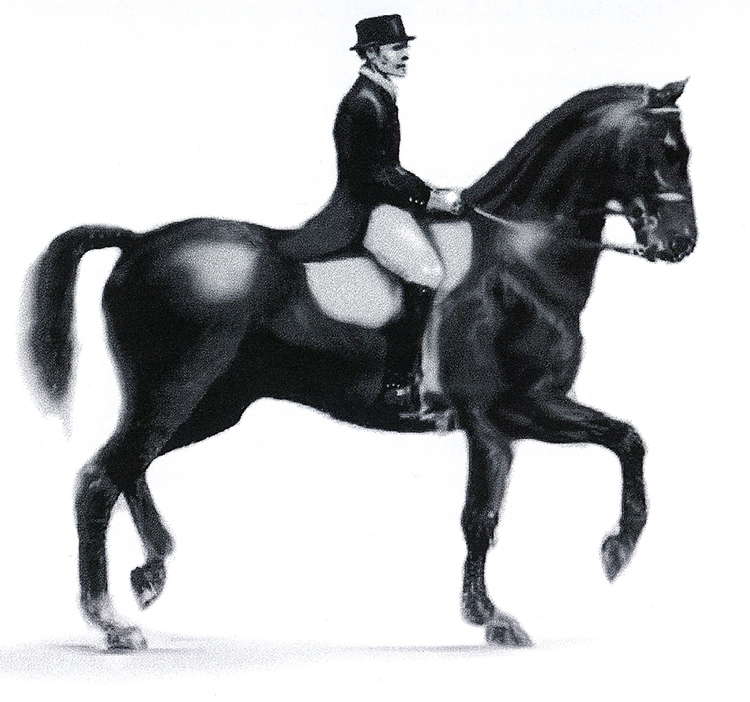
Hollow, grande passage
Is it bad conformation in horses? Over the years, I have measured hundreds of horse’s backs. I believe the length of the horse’s back can have an effect on its ability to collect. The shortest back we ever measured was approximately twenty-six inches. The longest back was thirty-eight inches. The length of the back doesn’t seem to have a relationship to the size or height of the horse. However, it seems that there comes a point when the back gets too long, that the horse will find it very difficult to engage the hips enough for collection. Dr. Hilary Clayton has pointed out that perhaps one of the most important conformational attributes for a sport horse is a forward sloping femur. So, it seems logical that conformation can affect performance However, today we have many examples of well-conformed horses with great athletic ability in many breeds. So, I don’t think conformation is the major cause of this epidemic of hollowness either.
Is it bad training? My feeling is yes. Horses are simply not being trained to come under behind. This training has to start early. When riders and trainers obsess on the front ends of horses, on neck and head systems (either low or high) or bending left and right, they don’t learn to have an awareness to develop the feel for the really important parts of the horse: those that are underneath and behind the saddle; the parts the rider cannot see. How many Grand Prix riders can more or less execute a trot – halt transition with the head in correct position, yet be unaware that the hocks are consistently buried in the jammed tail and that the back of the horse is hollow?
(Article continues below)
Breeding dressage horses? Go to www.ihb.com.au and see the range of top European bloodlines that are available in Australia – stallions like Fürstenball…
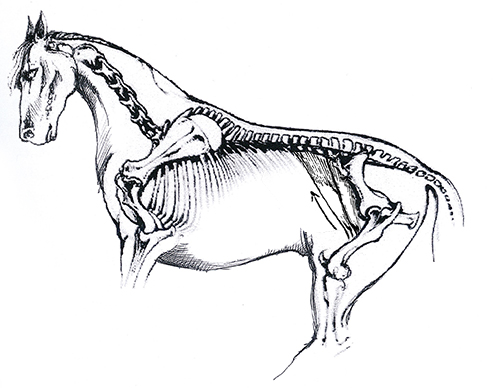
The psoas and iliopsoas are responsible for the flexion at the lumbrosacral area. This is the “sitting” that precedes true collection.
Collection is a technique. In collection, if we draw a line from the point of the buttocks perpendicular to the ground, the hocks and legs need to be in front of this line. Muscles like the cranialis tibialis flex and bring the hock forward, and there is a rotation with the hip as the center. However, it is really the psoas and iliopsoas that are responsible for this flexion at the lumbosacral area. This is the “sitting” that defines the engagement that precedes true collection. I say ‘precedes collection’ because first the horse must be taught to engage the hindquarters and then, as it gets stronger, the rider can increase the actual loading. It is the same as a weight lifter learning proper stance and good technique before trying to lift more weight. When young horses are ridden with low hands and long frames, stretched out on the forehand, the hind end actually becomes lighter. If this goes on too long, the core of the horse gets stiffer and weaker and the balance more and more on the forehand. The horse learns bad technique that affects future collection.
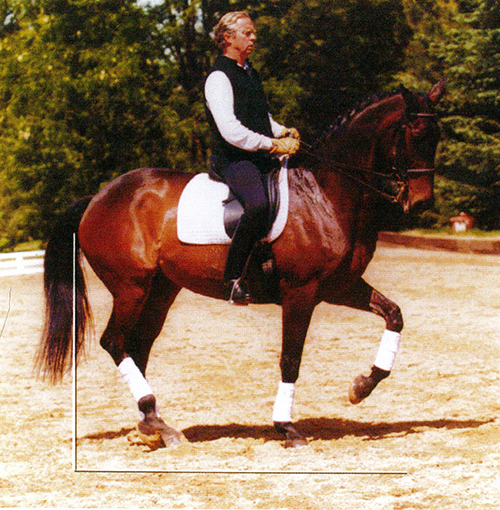
Young horses should learn this technique by being in crisp trot – halt transitions and walk – canter, canter – walk transitions. The rider needs to keep the seat light so that the back of the horse is encouraged to round up as it flexes at the lumbosacral joint, which brings the hind legs under the mass. The rider’s back and core must remain strong to prevent the horse from tipping the rider over or going through the rider’s hands and shoulders. In the beginning, most horses will try to go through the rider’s hands to make an easier transition on the forehand, but if the rider holds his or her position with passively unyielding hands, the horse will learn a different way to halt, bringing its hind legs under its body. The incredible thing is that as far back as the Duke of Newcastle, the value of these exercises was well known.
(Article continues below)
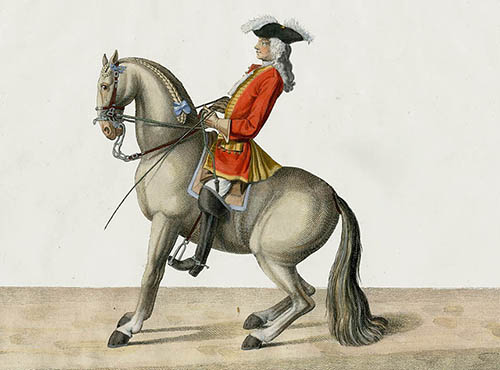
To paraphrase the Duke of Newcastle, “the whole object of the dressage horse is to get the horse upon the haunches, and let me tell you the best exercise I know: that is to trot and stop, to trot and stop.” When this exercise is done correctly, and the rider/trainer checks to see that both hocks are inside that perpendicular line from the point of the buttock to the ground, and that there are not walk steps in between the trot and the halt, the horse will progressively stop with less-and-less weight on the reins, as it balances the weight to the hind. This simple exercise can practically have as much value as piaffe, with the huge advantage that young or inexperienced horses can practice it and begin to develop the muscles and technique necessary for collection.
In the canter-walk transition, it is often easier for the inexperienced rider to feel the sitting or swinging under of the hind end. The rider needs to start in a quiet, ordinary canter. Within one fifteen meter circle, the rider will begin to swing the haunches more and more under through several progressive strides by primarily using the seat and back, adding the legs if the horse ignores the seat. Again, as in the trot-halts, the proof of correctness will be that as the horse gains more strength, and learns to use the hindquarters correctly, the rider will feel less and less weight in the reins at the moment of extreme deceleration. Obviously, the timing is critical and needs practice. If the rider interrupts the swinging haunches with a bouncing seat or drives too hard, too early, or too late in the stride, the rider may flatten the horse’s back and punish the iliopsoas and psoas, freezing up the action.
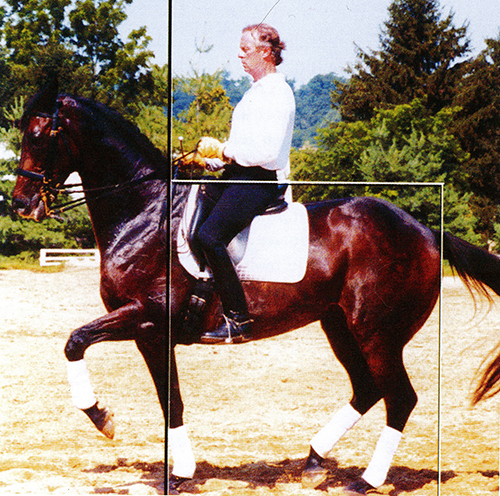
This is where modern riders seem to be very weak in theory and practice. Without learning proper form and feeling, they cannot teach their horses to progressively load and carry more weight as the training advances. Instead, as they increase the difficulty of the exercises, all kinds of evasions start occurring in the unprepared horse. Collection is not just squashing of the hindquarters or the lowering of the hind end or the speeding up of the step. It is the swinging under and transference of weight that defines collection. Like the good stance of the weight lifter, the coming under of the hindquarters on command makes the exercise beneficial instead of risky. These are the first steps, as the horse gets stronger, the ultimate expression of this gradual transference of weight is the levade, where virtually no weight is on the forehand. Even ordinary horses with practice can look more elegant as their balance improves.
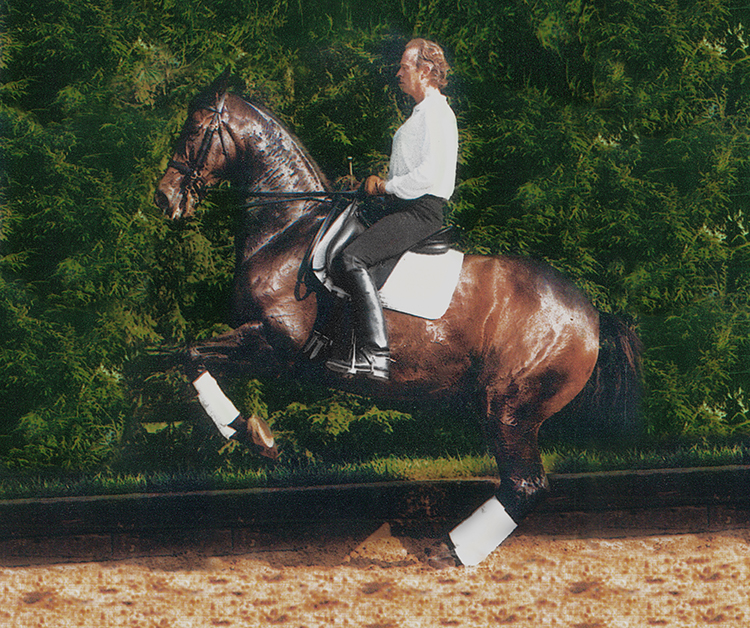
The levade
Good riders are receptive to good advice. I am convinced that riders should: 1) use more of these exercises which are easily quantifiable on their young horses (for example: at the halt, check to see if the hind legs are in front of the line from the point of buttock to the ground); 2) spend less time riding too forward with the horses’ necks too low; 3) practice more exercises which start moving the center of mass more to the rear, instead of to the shoulders, and 4) spend more time developing their feel and supple strength in the seat so they are aware of what is under and behind them. (Again, can riders tell without looking if at the halt the hind legs are underneath or not?) Then, I think riders would see excellent results and ultimately, so would the rest of us.
For my next article, I will address the elephant in the room: limb deviations.
want to learn more about Paul Belasik? Click http://www.horsemagazine.com/thm/2017/01/paul-belasik-why-are-fundamental-problems-persisting-in-elite-dressage/



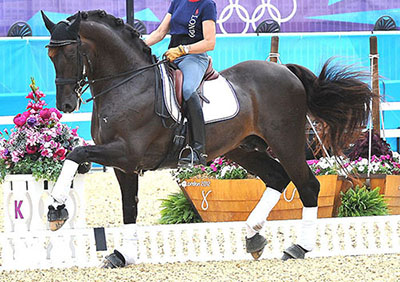
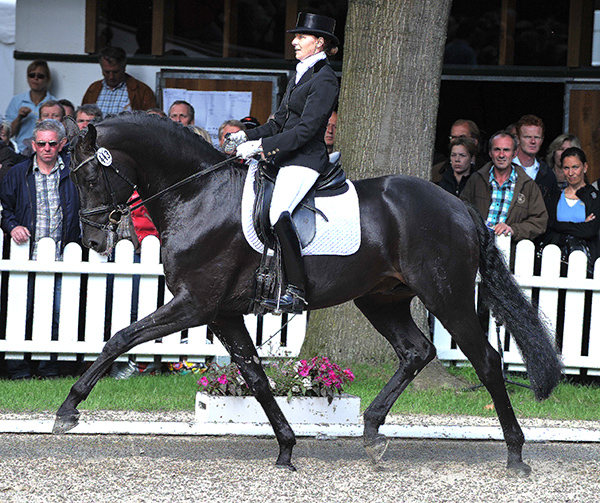
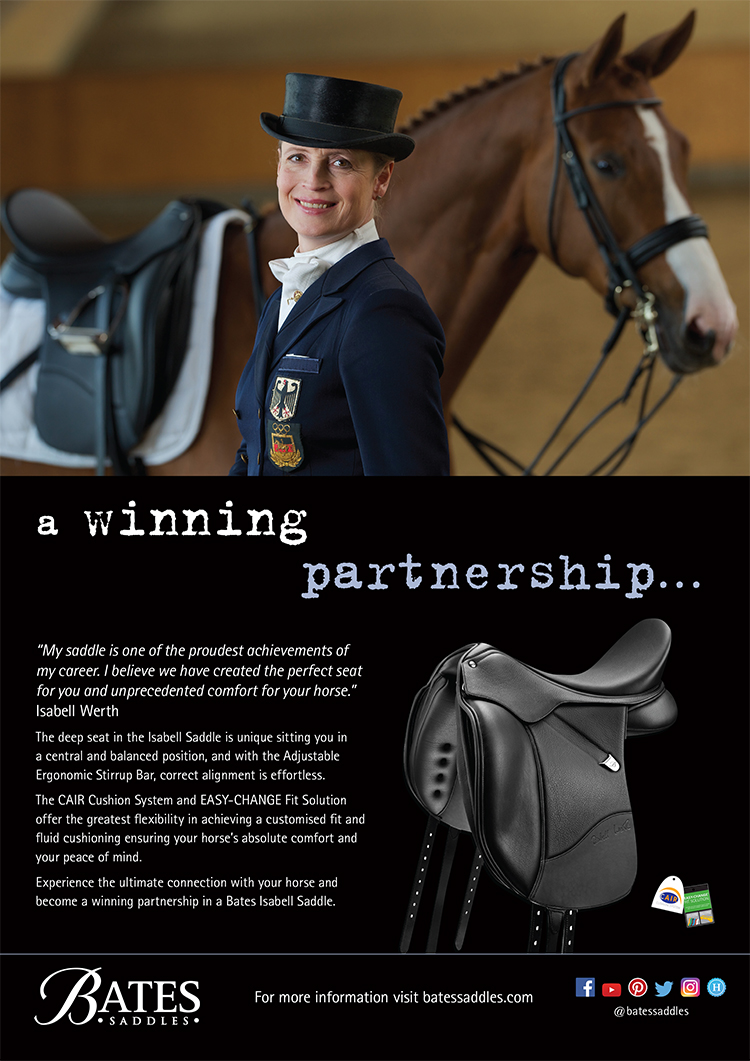
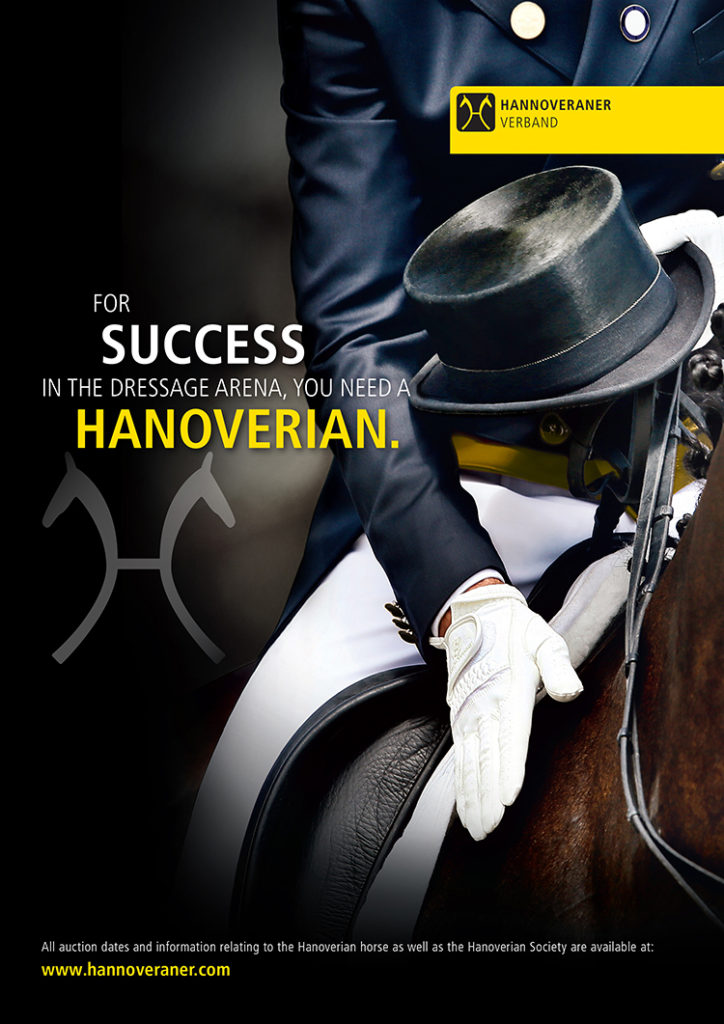
All international dressage competitors should read this article.
An excellent article
Jennifer Beechey
Fabulous read
I am really thankful to the owner of this
web page who has shared this enormous piece of writing at here.
The Counted Walk is not used these days to teach Collection, which is a shame as it is easier for horse and rider to understand the correct POSTURE of collection in FORWARD MOTION. Once that is learnt, all that is needed is to ask for Trot or Canter OUT OF the Counted Walk! Any horse can be taught this within Months, and does not need endless of kilometres ridden in Circles as in this Germanic way of riding, which not only bores the rider but the horse too. Counted Walk in Straight lines on a Hack where the horse and rider are travelling from A to B as the horse was designed by nature to do. Then add a Slow Trot and eventually a slow Canter. Simple and not so overly complicated as this article and countless others make Collection out to be! Remember horse were born knowing how to collect anyway. Use the Counted Walk (and ride in a Baroque Caveson and Weymouth Just like the rider in the Print above) to teach the horse how to give collection on demand (from the rider) that he already knows how to do. Dont spend years circling in all gaits in the vain hope that collection will come some day. It will never occur to the horse to offer Pelvic Tuck and elevated Chest at the same time. In a Counted Walk the Pelvis Tucks and the Chest Raises automatically. Once that “Convention and way of moving is inculcated in the horse when he has a rider on top, it is then understood that that is the POSTURE to Maintain in ALL gaits